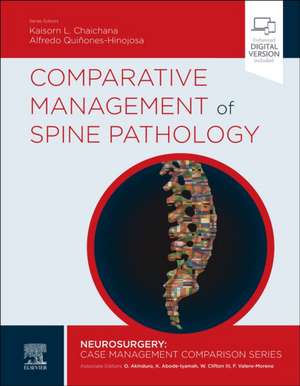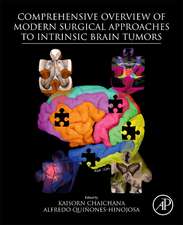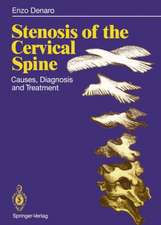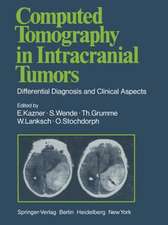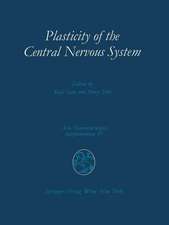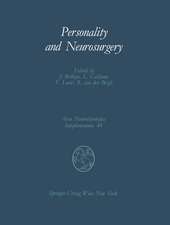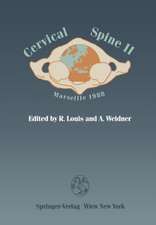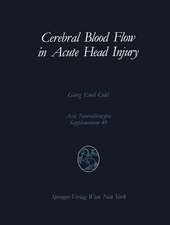Comparative Management of Spine Pathology: Neurosurgery: Case Management Comparison Series
Editat de Kaisorn Chaichana, Alfredo Quinones-Hinojosaen Limba Engleză Hardback – 13 aug 2022
Preț: 960.79 lei
Preț vechi: 1273.92 lei
-25% Nou
183.91€ • 199.83$ • 154.58£
Carte disponibilă
Livrare economică 25 martie-08 aprilie
Livrare express 15-21 martie pentru 316.74 lei
Specificații
ISBN-10: 0323825575
Pagini: 448
Dimensiuni: 216 x 276 x 24 mm
Greutate: 1.25 kg
Editura: Elsevier
Seria Neurosurgery: Case Management Comparison Series
Cuprins
- Degenerative spine
- Cervical
- One level cervical radiculopathy from facet/uncovertebral joint hypertrophy
- One level cervical radiculopathy from herniated disc in young patient
- One level cervical radiculopathy from herniated disc in older patient
- Cervical stenosis with preservation of lordosis
- Adjacent segment disease after single level ACDF
- Adjacent segment disease after PCF (cervicothoracic junction)
- Multilevel cervical stenosis from OPLL
- Multilevel cervical stenosis from 3-4 discs
- Anterior C1-2 pannus
- Basilar impression
- Thoracolumbar
- Adjacent segment disease at thoracolumbar junction
- Thoracic calcified disc (central)
- Lower thoracic disc herniation
- High lumbar stenosis (thoracolumbar junction)
- Lumbosacral
- Single level disc disease with back pain
- Radiculopathy from foraminal stenosis
- Grade 1 spondy without instability on flex/ext and claudication
- Grade 1 spondy with back pain only
- Grade 2/3 spondy
- >Grade 3 spondy
- Second herniated disc (same level) in a young patient
- Second herniated disc (same level) in older patient
- Flat back syndrome after laminectomy
- Lumbar pseudoarthrosis at L5-S1
- Pure back pain with multi level degenerative disc disease
- Cervical
2. Traumatic spine (10-15)
- Cervical
- Bilateral C2 pars fractures
- Type II acute odontoid fracture
- Type II chronic odontoid fracture in geriatric patient
- Unilateral cervical pedicle/transverse foramen fracture
- Central cord syndrome without instability
- Central cord with instability Vertebral artery injury with unstable cervical spine
- C1 burst fracture with TL disruption
- Thoracolumbar
- Compression fracture with back pain
- Burst fracture without PLC injury
- Burst fracture with PLC injury
- Pure bony Chance fracture
- Ankylosing spondylotic fracture
- Complete spinal cord injury
- Incomplete spinal cord injury
- Gunshot wound to the spine
- Lumbosacral
- Compression fracture
- Burst fracture without PLC injury
- Burst fracture with PLC injury
- Zone 3 sacral fracture
- Chronic L5 pars fractures with back pain and spondy
- Cervical
3. Spinal deformity
- Adolescent idiopathic scoliosis
- Scoliosis in cerebral palsy
- Proximal junctional kyphosis after T10-pelvis
- Isolated coronal deformity with back pain
- Coronal and sagittal deformity with back pain (adult idiopathic)
- Flat back after fusion
- Progressive cervical kyphosis after laminectomy
- Fixed cervical kyphosis (chin on chest)
- Degenerative scoliosis with one level radiculopathy
- Proximal junctional kyphosis after T3-pelvis
- Iatrogenic deformity after Harrington rod
- Broken rod after scoliosis correction with back pain
4. Spinal Oncology (10-15)
- Isolated met vertebral body (thoracic)
- Cervical epidural met (ventral)
- Multiple metastases to various levels, back pain only
- Multiple metastases with one level symptomatic
- Pathologic vertebral body fracture
- Meningioma
- Cervical chordoma
- Sacral chordoma
- Chondrosarcoma
- Schwannoma
- Ependymoma
- Glioma
- Giant Cell tumor
- Schwannoma
- Multiple neurofibromas
- Intradural schwannomatosis
- Hemangioblastoma
5. Other (epidural abscess or something like that) (10-15)
- Spontaneous CSF leak nerve root sleeve cyst
- Epidural abscess with stenosis without myelopathy
- Osteomyelitis with fracture
- Osteomyeltiis with back pain, no instability
- Infection post instrumentation
- Spinal Type I AVF
Descriere
Unique in the field, Comparative Management of Spine Pathology presents commonly encountered spinal cases with side-by-side, case-by-case comparisons that clearly show how various experts would handle the same case. This second volume in the Neurosurgery: Case Management Comparison Series offers multiple opinions from international experts in both neurosurgery and orthopaedics, each of whom explains their preferred approach and management style for the same case. This format allows for quick and helpful comparisons of different ways to approach a lesion, advantages and disadvantages of each approach, and what each expert is looking for in how they would manage a particular case.
Offers 4 expert opinions on each case in a templated format designed to help you quickly make side-by-side comparisons-an ideal learning tool for both trainee and practicing neurosurgeons and orthopaedic surgeons for board review and case preparation.
Helps you easily grasp different approaches to spine management with different expert approaches to the same case and summaries from the editors on the advantages and disadvantages to each approach.
Features a wide variety of management decisions, from preoperative studies to surgical approach, surgical adjuncts, and postoperative care, from experts in the field who specialize in different aspects of spine surgery.
Presents 70 cases in the areas of degenerative spine, traumatic spine, spinal deformity, spinal oncology, and miscellaneous topics such as epidural abscess, osteomyelitis, and post-instrumentation infection.
Enhanced eBook version included with purchase. Your enhanced eBook allows you to access all of the text and figures from the book on a variety of devices.
